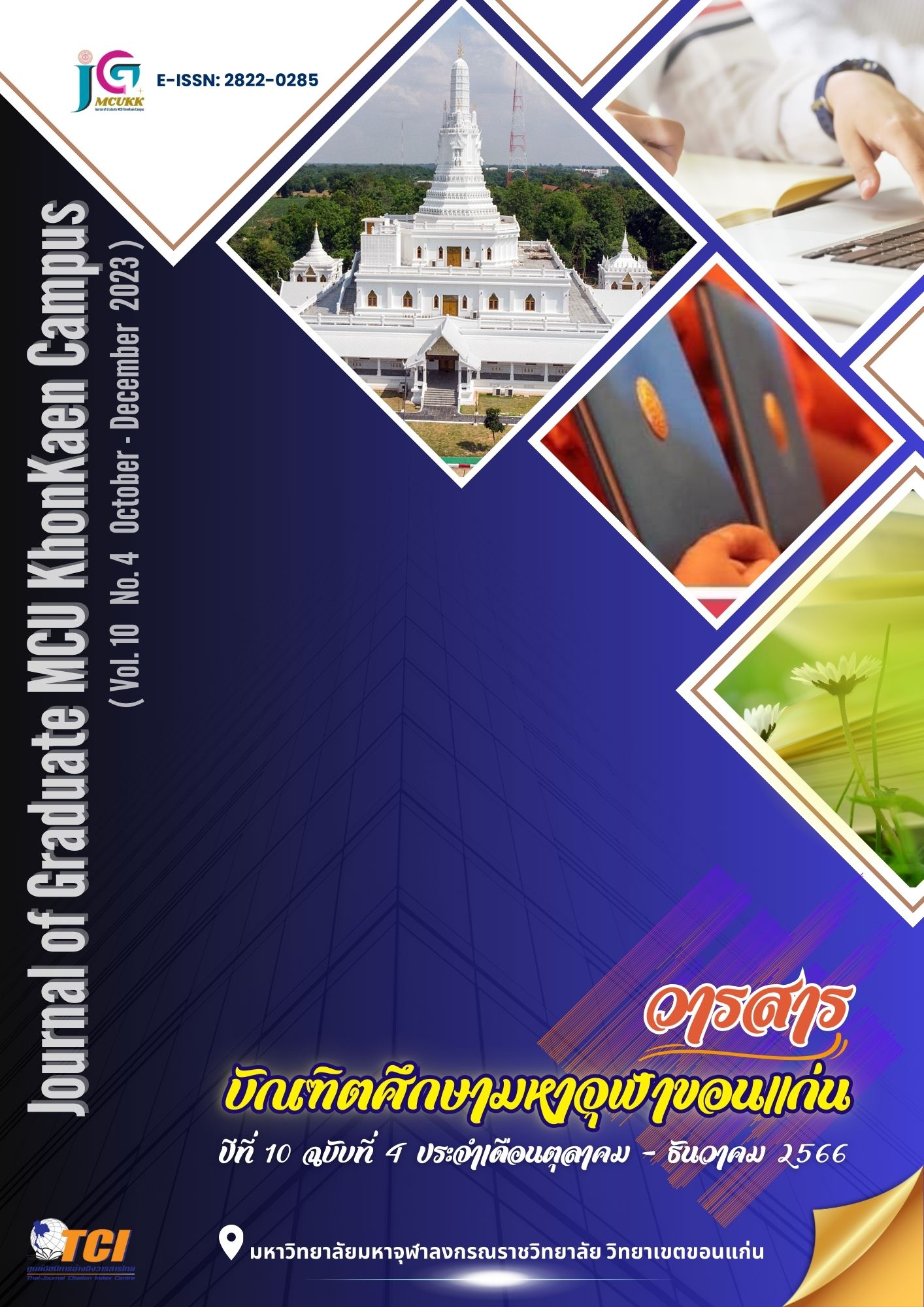การวิเคราะห์แนวคิดนัตถิกทิฎฐิในปรัชญาอินเดีย กับหลักอนัตตาในพุทธปรัชญาเถรวาท
Main Article Content
บทคัดย่อ
งานวิจัยนี้มีวัตถุประสงค์เพื่อ 1) ศึกษาแนวคิดนัตถิกทิฎฐิในปรัชญาอินเดีย 2) ศึกษาหลักอนัตตาในพุทธปรัชญาเถรวาท และ 3) วิเคราะห์แนวคิดนัตถิกทิฎฐิในปรัชญาอินเดียกับหลักอนัตตาในพุทธปรัชญาเถรวาท เป็นการวิจัยเชิงเอกสาร ศึกษาข้อมูลจากเอกสารปฐมภูมิ และทุติยภูมิวิเคราะห์ข้อมูลด้วยวิธีพรรณนาตามหลักอุปนัยวิธี
ผลการวิจัยพบว่า
1. นัตถิกทิฎฐิมีทัศนะว่า มนุษย์เกิดจากการรวมตัวของสสารคือธาตุ 4 เรียกว่า อัตตา เมื่อมนุษย์ตายไป สสารที่รวมกันแยกจากกันเป็นเพียงการดับสูญของอัตตา ธาตุ 4 ก็กลับคืนสู่ธาตุ 4 แนวคิดแบบอุจเฉททิฏฐิ แบ่งเป็น 3 ลักษณะ 1) หลังจากตายแล้ว อัตตาทุกชนิดจะขาดสูญ 2) หลังจากตายแล้ว อัตตาและโลกไม่เกิดอีก 3) ปฏิเสธความมีอยู่ทุกอย่าง ด้วยการปฏิเสธความไม่มีอยู่แห่งผลของการกระทำทั้งดีและชั่ว นอกจากนี้ยังมีทัศนะว่า สิ่งที่เป็นจริงจะต้องรับรู้ได้ด้วยประสาทสัมผัสเท่านั้น สิ่งที่มีอยู่จริงจึงมีเพียงสสารหรือวัตถุ สิ่งอื่นนอกจากนี้ เช่น อากาศ จิต อาตมัน ไม่ใช่สิ่งที่มีจริงเพราะไม่อาจรับรู้ได้ด้วยประสาทสัมผัส
2. พุทธปรัชญามีทัศนะว่า หลักอนัตตาเป็นการละความยึดมั่นในความเป็นตัวตน (อหังการ-มมังการ) และเป็นแนวทางในการปฏิบัติเพื่อให้เข้าถึงเป้าหมายสูงสุดด้วยความว่างจากตัวตนและการบรรลุพระนิพพานหลักอนัตตามีนัยครอบคลุม 3 กรอบ คือ 1) อนัตตาที่มีนัยครอบคลุมเฉพาะขันธ์ 5 2) อนัตตาที่มีนัยครอบคลุมสังขตธรรมทั้งหมด 3) อนัตตามีนัยครอบคลุมอสังขตธรรมคือนิพพาน พุทธปรัชญาปฏิเสธว่า อัตตาไม่มีเพราะว่า อัตตาเป็นเพียงการประชุมกันของธาตุซึ่งไม่ใช่สภาวะที่แท้จริง และสิ่งเป็นรูปธรรม และนามธรรม ย่อมเป็นไปตามกฎของเหตุปัจจัย
3. ผลการวิเคราะห์พบว่า แนวคิดนัตถิกทิฎฐิ มีทัศนะเกี่ยวกับชีวิตว่าเป็นเพียงการประกอบกันของธาตุ 4 เมื่อชีวิตสิ้นสุดลงสภาวะความเป็นธาตุ 4 ก็สลายไปกลับคืนสู่สภาวะเดิมไม่มีสิ่งใดที่จะเป็นเชื้อในการนำไปเกิดในภพใหม่จึงปฏิเสธการมีอยู่ในภพต่อไปซึ่งเจาะจงเฉพาะสิ่งมีชีวิตเท่านั้น ส่วนหลักอนัตตาเป็นการละความยึดมั่นในความมีตัวตน ซึ่งเป็นแนวทางในการปฏิบัติเพื่อให้บรรลุถึงเป้าหมายสูงสุด คือการบรรลุนิพพาน ซึ่งมีเนื้อหาที่ครอบคลุมถึงชีวิต (ขันธ์ 5) สังขตธรรม และอสังขตธรรม คือ นิพพานซึ่งสภาวะทั้งหมดนี้ล้วนตกอยู่ในกฎไตรลักษณ์ทั้งสิ้น
Article Details

อนุญาตภายใต้เงื่อนไข Creative Commons Attribution-NonCommercial-NoDerivatives 4.0 International License.
เอกสารอ้างอิง
กีรติ บุญเจือ. (2541). ปรัชญาสำหรับผู้เริ่มเรียน. (พิมพ์ครั้งที่ 11). กรุงเทพฯ: ไทยวัฒนาพานิช จำกัด.
นงเยาว์ หนูไชยะ ณ กาฬสินธุ์. (2544). การศึกษาเชิงวิเคราะห์แนวคิดเรื่องมิจฉาทิฏฐิในพระพุทธศาสนาเถรวาท. (วิทยานิพนธ์พุทธศาสตรมหาบัณฑิ). พระนครศรีอยุธยา: มหาวิทยาลัยมหาจุฬาลงกรณราชวิทยาลัย.
วนิดา เศาภายน. (2547). การศึกษาเชิงวิเคราะห์อุจเฉททิฏฐิในพระพุทธศาสนาเถรวาท ศึกษาเฉพาะกรณีที่ปรากฏในวรรณคดีไทย. (วิทยานิพนธ์พุทธศาสตรมหาบัณฑิต). พระนครศรีอยุธยา: มหาวิทยาลัยมหาจุฬาลงกรณราชวิทยาลัย.
มหาจุฬาลงกรณราชวิทยาลัย. (2539). พระไตรปิฎกภาษาไทย ฉบับมหาจุฬาลงกรณราชวิทยาลัย. กรุงเทพฯ: มหาจุฬาลงกรณราชวิทยาลัย.
พระธรรมปิฎก (ป.อ.ปยุตฺโต). (2539). นิพพาน – อนัตตา. (พิมพ์ครั้งที่ 3). กรุงเทพฯ: สหธรรมิก.
พระมหาสมจินต์ สมฺมาปญฺโญ (วันจันทร์). (2544). พุทธปรัชญาสาระและพัฒนาการ. กรุงเทพฯ: มหาจุฬาลงกรณราชวิทยาลัย.
พระชาญชนก ยโสธโร (ชาญทางการ). (2559). การศึกษาวิเคราะห์หลักธรรมในอนัตตลักขณสูตร. (วิทยานิพนธ์พุทธศาสตรมหาบัณฑิต). กรุงเทพฯ: มหาจุฬาลงกรณราชวิทยาลัย.

